|
IBCA
Guidelines for Product
ID, Labels and Shipments
(GPID)
1.0 Labeling and Shipping
Standards for Manufacturers
1.1
Introduction
1.2
Product Identification Using the GTIN for
Item, Inner Pack and Master Pack
1.3
Standard Item
Record (SIR) To Communicate GS1 (Formerly the U.P.C. Numbers)
1.4
Carton Packing
1.5 CARTON LABELING: Product
Identification and Shipping Label
1.6
Packing Slip
Preparation
1.7
Selling Unit
Packaging Requirements
1.8
Material Safety Data Sheets (MSDS)
1.9
Product Safety and Product Safety Labeling
1.10
Shipment Packaging and Pallets
1.1.1
This document provides further explanation of the guideline and identifies the
standards necessary to help you move your merchandise through the hobby industry
supply chain including retail stores and distribution centers.
1.1.2
In order to move products through the supply chain we must be able to
identify the products and then match the physical product and shipment to the
related transaction information. This
means that we must have a standard method to identify products and shipments
including the bar codes and labels.
We must also have a standard to deal with methods of communicating
information about shipments and the individual items contained in the
shipment.
1.1.3
In this section we will explain a standard for a "hard copy"
form to provide information about the individual item that will be used in a
variety of database applications and another "hard copy" form to
provide shipment information (manifest). The
forms will serve as models so that manufacturers and their customers can explain
the elements of information that they each need in order to conduct business.
Trading partners can establish their own methods to electronically
communicate the elements of information identified on the standard forms.
1.1.4
This section will also explain carton
labeling.
We would like to remind the reader that there are two kinds of labels
found on cartons. One identifies the product that is contained in the carton the
other provides shipping information. In fact there are a number of elements
essential to driving costs out of our supply chain. They are:
- Product
identification numbers (GTIN) and shipment identification.
-
Standard Item Records (SIR) containing information about a specific SKU.
- Complete
and accurate paperwork (forms and electronic files)
- Proper
carton and inner pack quantities
- Complete
and accurate label information
- Use
of strong packaging materials
1.2 Product Identification
Using the GTIN for Item, Inner Pack and Master Pack
1.2.1
Every item that is to be sold must have a unique product
identification number using the standards established by GS1 (Uniform Code
Counsel (UCC)).
The guidelines require this product identification method that
includes item identification, inner-pack and master-pack.
10.2.2
If this is your first involvement or if you need an overview we suggest
that you review the entire guidelines.
1.3 Standard
Item Record (SIR) To Communicate GS1 Information (Formerly the U.P.C. Numbers)
1.3.1
The product identification number that is found in the bar code is used
to access different data files in computer systems. Therefore manufacturers must
be able to provide some fundamental information in an electronic form. This
electronic file must contain, at a minimum, the product identification number
found in the bar code, the product catalog number, the description, the package
quantity and package dimensions. Various trading partners may require other
information about specific items. It is strongly recommended that companies
discuss the “Standard Item Record” with their trading partners.
1.3.2
Distributor and retailer inventory master files must be matched to the
manufacturer’s file using the GTIN number as a starting point (because of new
global capabilities, the GS1 now refers to the product identification number as
the global trade item number
(GTIN).
This is part of a movement to harmonize all retail item numbers called Sunrise
2005. An important point must not be overlooked. After the initial matching,
then the files must be maintained. This maintenance is called synchronization.
Any time something changes in a product master file (controlled by the
manufacturer) the item master files throughout the supply chain must be
synchronized with the manufacturer’s file. Therefore it is important to have two
capabilities, one for start-up matching and the other for ongoing
synchronization. The column heading (or titles) of the standard item record
(SIR) become a key that is used to relate the information in the records of one
company to the information contained in the records of another. A row is added
to the customers spread sheet (“User Field Names” shown in yellow) The SIR
numbers and titles are shown in the column of the corresponding information. See
field definitions in 1.3.3 below.
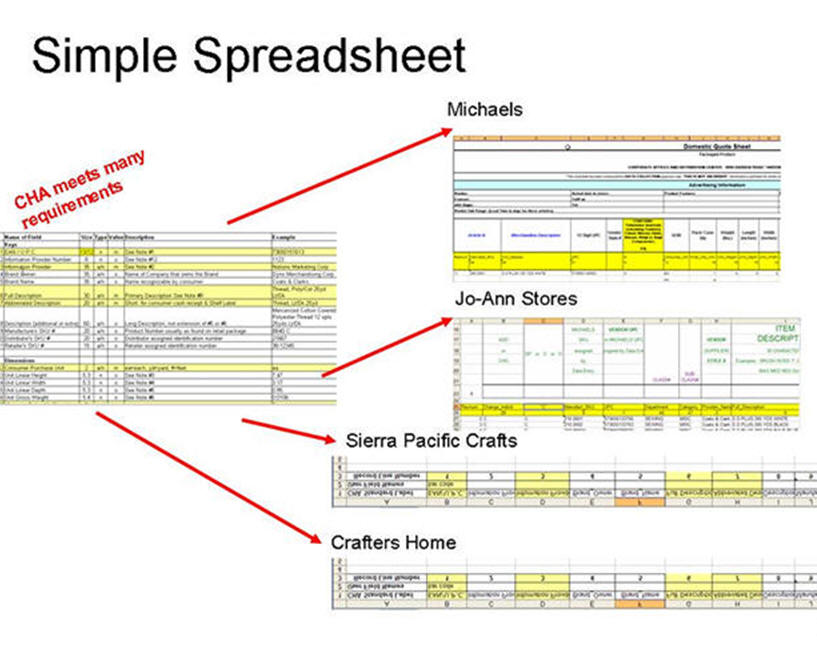
The example of a simple spreadsheet shows how the
data required by several different customers can be matched to the SIR column
titles. These examplers were taken from the craft and hobby supply chain.
Contact your trading partner for the latest, up to date records.
1.3.3
Below we have provided an
example of the standard item record (SIR) using an Excel™ spreadsheet. The
example shows the elements of information that a retailer can expect to be
contained in the item master file. The elements of information are arranged in
the rows in this example so that they can be seen on one page. The Excel™
spreadsheet that can be downloaded for
FREE. is set up with the
information elements in columns since that arrangement is easier to be imported
by a computer. NOTE: The field numbers and names are the same in both layouts.
The field names, at the top of the columns, must not be changed since they are
directly related to the XML tags. To help users reference their own field names,
a row is provided “User Field Names.” User can enter their own filed names into
those cells.
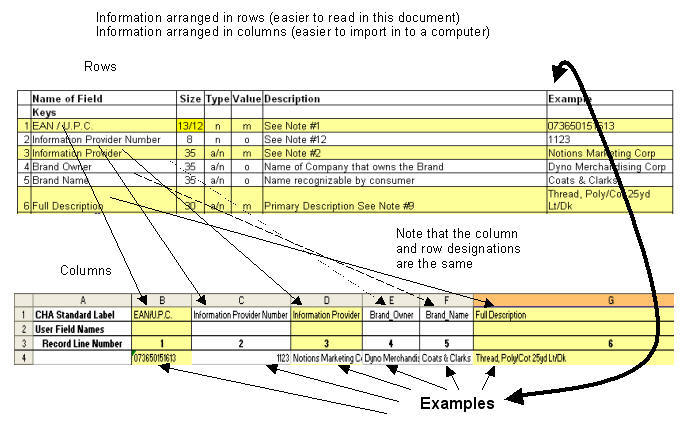
The spreadsheet serves as a model to help companies
communicate with their trading partners. Using Excel™ enables the least
sophisticated companies to communicate with even the most sophisticated. Even
the least sophisticated company can import and export Excel™ format. Of course,
the most sophisticated can use the Excel™ files. The advanced user can employ
XML tags (Excel 2003™) that enable many different computers and software systems
to automatically load and interact, in real time, over the Internet. (.Net and
Web Services)
Please be aware that trading partners may have
additional data requirements based on customer / vendor relationships that are
not specifically shown in here. Those other elements can be provided in any of
the eight “Generic” fields shown. Microsoft Excel is the standard format for
data sharing.
-
Size This column describes the size of data
field.
-
Type “a” represents alphabetic “n” represents
numeric “a/n’ represents alpha numeric
-
Value “m” represents mandatory “o” represents
optional “r” represents recommended
Database Record Format
|
|
Name of Field
|
Size
|
Type
|
Value
|
Description
|
Example
|
|
|
KEYS
|
|
|
|
|
|
|
1 |
EAN / U.P.C.
|
13/12 |
n |
m |
See Note #1
|
073650151613
|
|
2 |
Information Provider #
|
8 |
n |
o |
See Note #12
|
1123 |
|
3 |
Information Provider
|
35 |
a/n |
m |
See Note #2
|
Notions Marketing Corp
|
|
4 |
Brand Owner
|
35 |
a/n |
o |
Name of Company that
owns the Brand |
Dyno Merchandising Corp
|
|
5 |
Brand Name |
35 |
a/n |
o |
Name recognizable by
consumer |
Coats & Clarks
|
|
6 |
Full Description
|
30 |
a/n |
m |
Primary Description See
Note #9 |
Thread, Poly/Cot 25yd
Lt/Dk |
|
7 |
Abbrev. Description
|
20 |
a/n |
m |
Short: for consumer
cash receipt & shelf label |
Thread, Lt/Dk 25yd
|
|
8 |
Description (additional
or extra) |
60 |
a/n |
o |
Long Description, not
extension of #5 or #6 |
Mercerized Cotton
Covered Polyester Thread 12 spls 25yds Lt/Dk |
|
9 |
Manufacture's SKU #
|
20 |
a/n |
m |
Product # usually as
found on retail package |
B640 C |
|
10 |
Distributor's SKU #
|
20 |
a/n |
o |
Distributor assigned
identification number |
21667 |
|
11 |
Retailer's SKU #
|
15 |
a/n |
o |
Retailer assigned
identification number |
38-12345 |
|
|
DIMENSIONS
|
|
|
|
|
|
|
12 |
Consumer Purch Unit
|
2 |
a/n |
m |
ea=each, yd=yard,
ft=feet |
ea |
|
13 |
Unit Linear Height
|
5.3 |
n |
o |
See Note #3
|
7.47 |
|
14 |
Unit Linear Width
|
5.3 |
n |
o |
See Note #4
|
3.17 |
|
15 |
Unit Linear Depth
|
5.3 |
n |
o |
See Note #5
|
0.95 |
|
16 |
Unit Gross Weight
|
5.4 |
n |
o |
See Note #6
|
0.0106 |
|
17 |
Min Orderable Qty
|
6 |
n |
m |
|
3 |
|
18 |
Inner Orderable Unit
|
6 |
n |
o |
Qty of consumer purch.
items in inner pack |
3 |
|
19 |
Inner Pack GTIN
|
14 |
n |
m |
See Note #13
|
20073650151617 |
|
|
|
|
|
|
|
|
|
20 |
Case Orderable Unit
|
6 |
n |
o |
Qty of consumer purch.
items in case pack |
120 |
|
21 |
Case Pack GTIN
|
14 |
n |
m |
See Note #13
|
40073650151611 |
|
22 |
Case Height
|
5.3 |
n |
o |
See Note #10
|
15.25 |
|
23 |
Case Width |
5.3 |
n |
o |
See Note #10
|
11.625 |
|
24 |
Case Depth |
5.3 |
n |
o |
See Note #10
|
13.875 |
|
25 |
Case Gross Weight
|
5.3 |
n |
o |
See Note #11
|
15.54 |
|
|
DATES
|
|
|
|
|
|
|
26 |
Publication Date
|
8 |
n |
m |
See Note #7
|
|
|
27 |
Effective Start Date
|
8 |
n |
m |
See Note #8
|
|
|
28 |
Change Indicator
|
1 |
a |
m |
a=Add, c=change,
u=Update, d=Discontinued |
|
|
29 |
Last Change Date
|
8 |
n |
o |
ex: yyyymmdd
|
20040131 |
|
|
MISCELLANEOUS
|
|
|
|
|
|
|
30 |
Mfg Suggested Retail
|
8.2 |
n |
m |
MSRP Price of consumer
level unit |
3.55 |
|
31 |
Unit Cost |
8.3 |
n |
o |
ex: 2.125 Cost of
single consumer purch. unit |
1.598 |
|
32 |
Inner Cost |
8.3 |
n |
o |
Total cost of quantity
of units in inner pack. |
4.794 |
|
33 |
Case Cost |
8.3 |
n |
o |
Total cost of quantity
of units. Ex: 74.160 |
159.72 |
|
34 |
Country of Origin
|
2 |
a/n |
o |
ex: us=USA, uk=United
Kingdom |
TW |
|
35 |
Int’l Tariff Code
|
10 |
n |
o |
ex: 1234567890
|
9608.00.0000
|
|
36 |
Generic |
* |
n |
o |
Size & Use determined
by Trading Partners |
|
|
37 |
Generic |
* |
n |
o |
Size & Use determined
by Trading Partners |
|
|
38 |
Generic |
* |
n |
o |
Size & Use determined
by Trading Partners |
|
|
39 |
Generic |
* |
n |
o |
Size & Use determined
by Trading Partners |
|
|
40 |
Generic |
* |
a/n |
o |
Size & Use determined
by Trading Partners |
|
|
41 |
Generic |
* |
a/n |
o |
Size & Use determined
by Trading Partners |
|
|
42 |
Generic |
* |
a/n |
o |
Size & Use determined
by Trading Partners |
|
|
43 |
Generic |
* |
a/n |
o |
Size & Use determined
by Trading Partners |
|
Standard Item Record Format Notes
Note #1 Most people are familiar with the GTIN-12
item bar code (12 digits formerly the U.P.C.). Products from outside North
America use a compatible bar code called the GTIN-13 (formerly EAN-13 digits)
Either number can be used in this field. Note that there have been some changes
to the number structure. You do not need to change any U.P.C. item numbers. See
note 13
Note #2 A name of the person or organization; i.e.
Manufacturer, Distributor, Broker providing this information.
Note #3 The measurement of the height of the trade
item at its vertical dimension from the lowest extremity to the highest
extremity, including the packaging in inches to the third decimal. Measure as if
description label is readable from left to right in most common way of display.
Note #4 The measurement of the width of the trade
item at its horizontal dimension from the left extremity to the right extremity
including the packaging in inches to the third decimal. Measure as if
description label is readable from left to right in most common way of display.
Note #5 The measurement of the depth of the trade
item at its most extreme depth in inches to the third decimal. Measure as if
description label is readable from left to right in most common way of display.
Note #6 The gross weight includes all packaging
materials of the trade item measured in pounds to the fourth decimal.
Note #7 The creation date on which all static data
associated with the trade item becomes available for viewing and
synchronization. (Ex: yyyymmdd)
Note #8 A date when the buyer can first order the
item. (Ex: yyyymmdd)
Note #9 Full Description; this should be the Primary
Description of this product and sufficiently detailed to distinguish it from
other products.
Description may be up to 30 characters including
spaces, commas, periods, dashes or any other special characters. In order to be
an effective description, store employees need to be able to tell what the item
is. Therefore, begin with a broad category description then identify the color,
dimensions or style. In addition, in many systems the customers only see the
first 15 characters of the description on the register receipt, so the first
characters need to define the category of product. Below you will find some
examples of good and bad descriptions.
|
Good Descriptions |
Bad Descriptions
|
|
Brush, Camel Hair
Rd 3 |
#3 Round
|
|
T-Shirt, Large Blue
|
Lg Blue T-Shirt
|
|
BK, Floral Spring
Arrangements |
Spring Arrangements
|
|
Wire, Wild Blue,
4 yard |
4 Yd Blue Wire
|
Note #10 The measurement of the height, width and
depth of the shipping carton measured in inches.
Note #11 The gross weight of the shipping carton,
its contents and any packing or void fill.
Note #12 The numeric representation of the provider
of the data as defined by the trading partners.
Note #13 Global trade item number (GTIN) Higher
levels of packaging, above selling unit (see field 1) should be presented as a
14 digit GTIN. The various numbering systems have been harmonized as part of UCC
Sunrise 2005. If you have more than three levels of packaging, eg. Item, carton
master, use generic fields (36 through 43) for GTIN followed by dimensions.
1.4 Carton Packing
This
section deals with packing merchandise for transit to distribution centers as
well as shipments direct to stores. First, we must explain the configuration
terminology and requirements.

1.4.1
Product Packing Configurations
The
packing configurations will define the lowest level of store selling unit
(each), how many “eaches” will be packed as a group (inner pack), and
finally how many eaches and inner packs are in a master case.
Most
major retailers will work with the vendor’s existing production standards to
promote manufacturing efficiencies for the vendor, and distribution efficiencies
for the retailer. When the
configurations are defined, they must remain consistent throughout the
product’s lifecycle. Do not ship
in the new configuration prior to reaching approval from your trading partner.
1.4.2
Single SKU in Cartons
Each
shipping carton should contain only one SKU, unless the order is a specific
assortment requested by your trading partner.
However, there may be some deviations from this normal rule.
Be sure to discuss this with your trading partner. Each different packing
level or configuration will have a different 14 digit GTIN.
1.4.3 Inner Pack / Storage Case
The
inner pack or storage case quantity is the total number of selling units grouped
together in a “bundle”. Several
bundles or inner packs may exist in a master pack.
The product is usually grouped inside of bags, smaller cartons or plastic
wrap. The
inner pack quantity must be consistent for the same SKU for all orders.
1.4.4
Master Packs
A
master pack quantity is the total number of selling units (eaches) within the
master case. The master pack
quantity must be consistent for the same SKU for every order.
1.4.5
Packaging
Typically
distribution centers will select individual units, inner packs, master packs and
even full pallets to fulfill store inventory demands.
Whenever possible, products should be packaged in corrugated cardboard
boxes. The following standards
should be applied whenever possible. It
is recognized that there are rare exceptions when the product size or shape does
not allow for packaging in corrugated cardboard boxes.
These exceptions should be discussed with trading partners for approval
prior to shipment to the distribution centers or stores.
-
Selling
units (“eaches”)
each carrying a GS1 12, 13 or 8 bar code should be packaged based on trading partner
requirements when the product was first set up with the buyer.
However, additional filler material may be required to protect the
merchandise from soiling, breaking or deteriorating. Biodegradable materials are preferred for filler material.
-
Inner
packs and/or storage cases:
-
Each
must carry a 14 digit GTIN presented in GS1-128 bar code.
To allow the distribution centers to use conveyor systems, many retailers prefer
that the packaging for all inner packs and/or storage cases that are at least
5”H x 4”W x 2”L and weigh at
least 2 lbs. be a shippable carton.
-
Merchandise which measures less
than 11”H x 11”W x 16”L and is not packed in a shippable inner pack carton
may be overpacked with other merchandise for shipment to the store inside a
repack box. The packaging used must be sufficient to protect the merchandise
from damage or soiling as it is handled and shipped to the stores in the repack
box.
-
Some distribution centers and
retailers have re-pack boxes of specific dimensions. It is important that you
discuss your packaging capabilities and their requirements.
-
Inner
packs/storage cases for Seasonal or Special Event Merchandise:
-
Inner pack / storage case
quantities for seasonal merchandise must be packaged together in shippable
containers within the master pack.
-
Some retailers have very specific
requirements about the nature of inner packs/storage cases and seasonal
merchandise. Make sure that you
understand their requirements if any exist.
-
Master
packs must
carry a 14
digit GTIN presented in GS1-128 bar code.
Merchandise should be protected in
a shippable carton that can be transported and handled without tearing or
breaking. Shrink-wrap, plastic bags, or straps may not be acceptable for master
carton packaging for some retailers. Fragile
merchandise should be packed with material that allows the cartons to be
transported from the vendor’s site to the final destination without damage.
If breakage is common for certain merchandise, the vendor will need to
take steps to improve the method or type of packaging.
Typically, the cardboard quality must be 175-pound test corrugated to
protect your merchandise.
-
Seal
the carton using polypropylene film
(plastic) box-sealing tape, glue and/or staples. Do not use paper tape that utilizes a water-based adhesive to
seal your boxes.
-
It
is extremely important that the size
of the carton selected for a SKU remains consistent for all orders.
The distribution centers allocate storage space based on the original
carton size and quantity of the cartons. If
merchandise allows, shipping cartons should be within the dimensions listed in
the table below. This allows the
distribution centers to process merchandise via conveyor systems.

-
Use
of plastic or metal banding may be prohibited
on all master cartons, inner pack boxes and pallets being shipped to a number of
retailers. If your merchandise is
exceptionally heavy or dense, you should contact the trading partner to request
an exception to this rule.
1.4.6
Proper Packaging Summary:
It
is your responsibility to ensure product is packaged to prevent damage or loss.
Do not ship your goods without the correct protection.
Below are some basic guidelines for proper packaging.
-
Use a carton of at least 175 pound
test strength
-
Use adequate cushioning material
-
Secure with polypropylene film tape
designed for shipping
-
Affix proper labels to each carton
as described in the section on carton labeling requirements
-
The shipping label must display a
complete return address
-
Be sure to discuss the use of metal
or plastic banding to secure master cartons, inner pack boxes, or pallets with
your trading partners if you intend to use them
1.5
CARTON LABELING: Product Identification and Shipping Label
This
section deals with carton labeling.
We would like to remind the reader that there are two kinds of labels
found on cartons. One is for
product identification telling what is contained in the carton; the other carton
label is the shipping label.
Figure
1 – Product Identification and Shipping Label Location
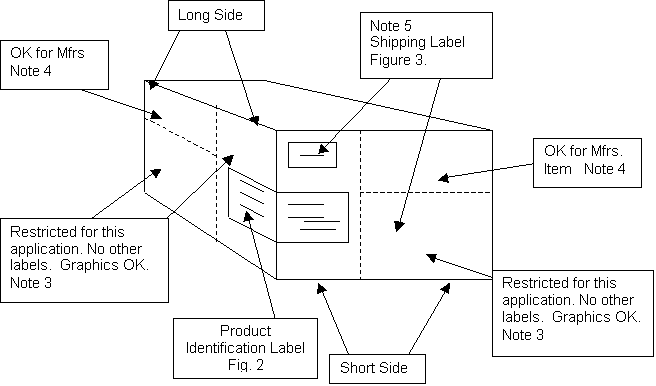
Notes:
This
is to be the location for the label described in Figure 2 and the Shipping Label
in Figure 3 (when placed on an individual inner-pack or master carton).
1.
Labels should wrap around and be in the
lower left quadrant of the short side of the master carton.
2.
The area from the bottom to the top of the
carton and 7 inches back from the corner is reserved for this application. No
other labels are to be placed there but carton graphics are permitted.
3.
If manufacturers must use a second label
for internal systems, the second label must be as close to the top of the carton
as possible to avoid confusion.
4.
The bottom of the product ID label should
be parallel to the bottom of the case.
5.
If the master carton is not high enough
for a shipping label to be placed above the master carton label, place the
shipping label in the area to the right of the master carton label on the short
side of the master carton.
1.5.1 Product Identification Label Specifications
Figure 2 – Product ID Label With Bar
Codes (not to scale)
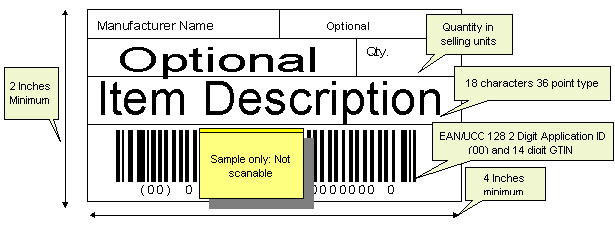
- Label
Purpose – To be used on a single container (either master carton, storage
case, or inner-pack) holding one or more items with a single part number.
- The
Carton Product Identification Label design is based on the bar code label
standards developed by GS1 (formerly the Uniform Code Council (UCC)).
- The
“Global
Trade Item Number”
(GTIN) as it is referred to by the GS1 is contained in the bar code. The GTIN is
the primary method of product identification. It is the number used in the item
master file and the number used to identify each product shipped on the
manifest, packing slip or electronic file called an ASN.
- All
bar codes use GS1-128 symbology. The bar code will have a minimum height
of ½ inch.
- The
preference is for the shipping label to be located in close proximity to the
master carton label on the short end of the master carton (See Figure 1).
- The
mandatory blocks of information are the manufacturer, the description and the
GTIN bar code with human readable information below it.
The other blocks are optional but should be agreed to by the trading
partners to avoid any confusion on the part of employees who must handle and
identify the products.
- All
print fields should be left justified and centered vertically within each block
of data.
- Fonts
shall be in upper case bold Arial or Arial Narrow, or equivalent.
- Each
block of data on the label will have a human readable block definition. The minimum
recommended Font Sizes by the Uniform Code Council are:
- 9
pt is equivalent to 0.125 (1/8”) in height for block identification
- 36
pt is equivalent to 0.500 (1/2”) in height for other text
- Please
note the above font sizes are nominal and may need to be adjusted depending on
your printer software.
- There
is a preference to print a box around each of the individual blocks of data on
the label.
- There
may be a preference for a wrap around product identification label.
The wrap around label may be printed on a single label or two separate
labels. When two separate labels
are used, the labels should be located on adjacent sides of the carton in the
assigned space. With a wrap around
label, the right half is to be a mirror image of the left half.
All of the field positions are reversed.
For example, in Figure 2, the blocks containing the optional, quantity,
description and GTIN bar code fields will be on the right for the left label,
and on the left for the right label.
Different
retail stores and retail chains may have a variety of different logistics
systems. For example, some vendors may be shipping to stores; others may be
shipping to distribution centers. Below
is a model of the shipping label to carry the most fundamental of information.
Manufacturers should discuss specific needs with their customers since
there may be a requirement for some additional or slightly different information
based on the specific logistics system.
-
Overview
of Label Layout
An
important bar code standard has been approved by ANSI (American National
Standards Institute). The standard
is called American National Standard for Materials Handling - Unit Load and
Transport Packages - Bar Code Symbols (henceforth referred to as ANSI MH10.8).
The standard is important because it makes it easier for companies and
industries to develop comprehensive shipping label specifications using a format
developed and maintained by an internationally accepted standards-setting body
… ANSI.
-
ANSI
MH10.8 Framework
ANSI
MH10.8 is a guideline or "framework" for developing shipping label
specifications. The MH10.8
addresses all the important issues of a standard and it simplifies the process
of developing a shipping label
specification (not product identification labels; mentioned earlier). This
guideline has used this framework to develop its model label.
-
The label consists of three key
segments: 1) the customer segment, at the top of the label 2) the carrier
segment, beneath it and 3) the supplier segment at the bottom.
-
Each segment is divided into blocks
and each block can be divided into sub-blocks.
-
Separator lines delineate the
blocks and vertical separators designate sub-blocks.
1.5.3
Shipping Labels
Regardless
of whether the shipment is an express shipment, LTL, or even a truckload, the
vendor must affix a label, at least 4” x 6” in size, with information found
in the example below on each carton in the shipment.
Label
Example
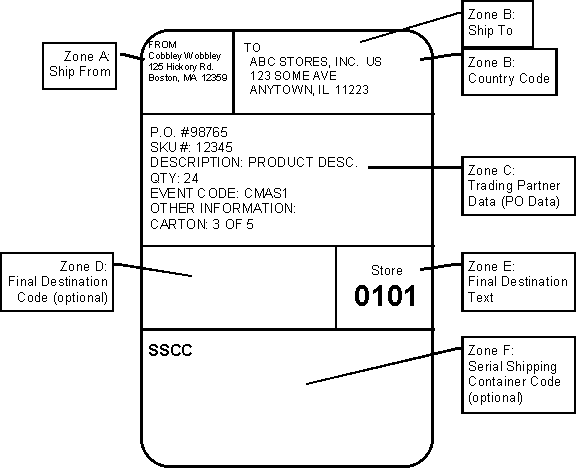
Table
2: DC Shipping Labels Block and
Content Requirements and Recommended Block Dimensions and Text Formats
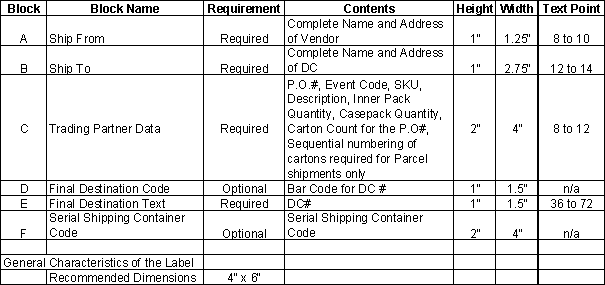
1.5.4
Application of Shipping Labels to Shipping Containers
All
shipping labels must be legible and complete, with shipper and consignee
information corresponding with the bill of lading.
For shipments sent directly to the stores, the lead carton (box #1 in the
shipment) containing the Packing Slip should be clearly marked “Packing Slip
Enclosed”. For shipments being
sent to a distribution center, the packing list must be affixed to the outside
of the lead carton or pallet in an envelope marked “Packing Slip Enclosed”.
For truckload shipments, attach the envelope to a pallet at the rear of
the trailer.
Guidelines
for placing labels are shown below. You
must affix the label to the side of the box if the dimensions of the box allow.
However, if the box size does not allow the entire label to be affixed to
the side of the box, you may place it on the top of the box.
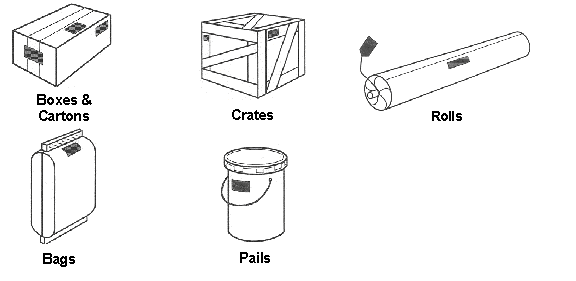
A
packing slip is required for all shipments to retail stores, distribution
centers and third-party facilities. The packing slip contains critical information to properly
identify and receive merchandise at stores and distribution centers.
Retailer employees use this information to help identify, sort and
confirm merchandise quantities. Retailer
Accounts Payable departments also use packing slips as supporting paperwork for
vendor payments. Packing
slips must reflect the actual shipment contents. Missing packing slips or inaccurate information on a packing
slip causes delays in receiving which prevents the product from being placed in
inventory or made available for sale to a customer. These types of errors could also delay payments to vendors.
For shipments going to a distribution
center, packing slips should be securely affixed to the lead carton or pallet
inside an envelope marked “Packing Slip Enclosed”. For shipments going directly to the stores, the lead carton
should be marked as containing the packing list.
Packing
slips are always in paper format and must be included with each shipment of
merchandise. Below is a model
manifest (packing slip). Not all
packing slips will be the same for all vendors. The model should be used to help vendors and customers
understand each other’s needs and capabilities to provide the necessary
information. The minimum required
information should be presented in a format that is legible and organized for
efficient receiving.
Please
note: A separate packing slip is required for each purchase order within the
shipment.
1.6.1
Packing List / Manifest
(see Description of Fields)
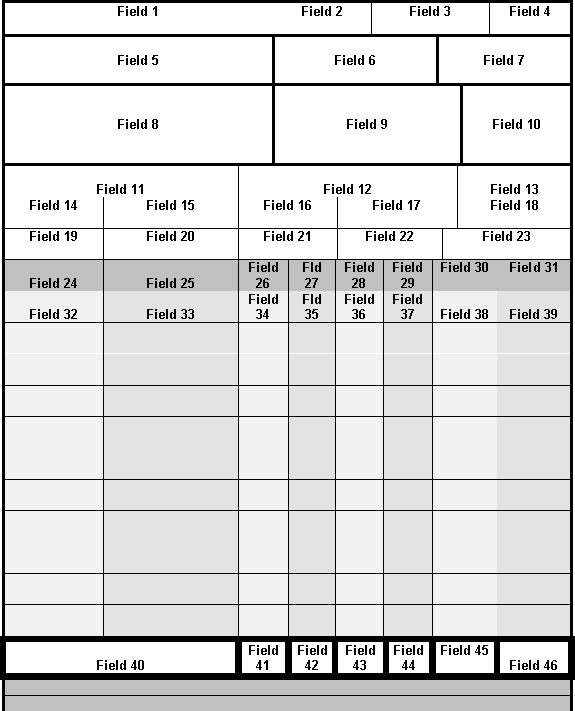
1.6.2
Description of Fields
|
FIELD
|
TYPE
|
CONTENT
|
|
1
|
Text
|
Form
Title : MANIFEST or PACKING LIST ( Large font size )
|
|
2
|
Data
|
Order
Number (for internal use)
|
|
3
|
Data
|
Date
|
|
4
|
Data
|
Page
number/Total pages
|
|
5
|
Data
|
Carrier
ID
|
|
6
|
Data
|
Country
/ Point of Origin
|
|
7
|
Data
|
Manifest
Number
|
|
8
|
Data
|
Ship
To Address
|
|
9
|
Data
|
Routing
Information
|
|
10
|
Data
|
|
|
11
|
Data
|
Customer
Purchase Order Number
|
|
12
|
Data
|
Terms
|
|
13
|
Data
|
Date
Loaded
|
|
14
|
Data
|
charge
Class
|
|
15
|
Data
|
Mileage
|
|
16
|
Data
|
Trailer
ID
|
|
17
|
Data
|
Trailer
Seal Number
|
|
18
|
Text
|
|
|
19
|
Data
|
Total
number of unit loads
|
|
20
|
Data
|
Total
number of extra pieces
|
|
21
|
Data
|
Total
quantity in each units
|
|
22
|
Data
|
Total
cubic feet
|
|
23
|
Data
|
Total
weight
|
|
24
|
Text
|
Title
Field : ITEM NUMBER
|
|
25
|
Text
|
Title
Field : ITEM DESCRIPTION
|
|
26
|
Text
|
Title
Field : QUANTITY
|
|
27
|
Text
|
Title
Field : UNIT LOAD
|
|
28
|
Text
|
Title
Field : EXTRA
|
|
29
|
Text
|
Title
Field :COUNT
|
|
30
|
Text
|
Title
Field : VARIANCE
|
|
31
|
Text
|
Title
Field : TOTAL WEIGHT
|
|
32
|
Data
|
UPC/GTIN
|
|
33
|
Data
|
Item
Description
|
|
34
|
Data
|
Quantity
each
|
|
35
|
Data
|
Quantity
of unit loads
|
|
36
|
Data
|
Quantity
of non unit loads
|
|
37
|
Data
|
Total
quantity of units for this line item
|
|
38
|
Data
|
Any
difference from ordered quantity
|
|
39
|
Data
|
Total
weight of this line item
|
|
40
|
Text
|
Title
Field : TOTALS
|
|
41
|
Data
|
Column
total for Quantity
|
|
42
|
Data
|
Column
total for Unit Loads
|
|
43
|
Data
|
Column
total for Non Unit Loads
|
|
44
|
Data
|
Column
total for total units
|
|
45
|
Data
|
Column
total for Variance
|
|
46
|
Data
|
Column
total for Total Weight
|
|
47
|
Text
|
Free
text area for handling instructions
|
1.6.3
Example

1.7
Selling Unit Packaging Requirements
1.7.1
Introduction to GS1 (formerly U.P.C.) Selling Unit Labeling
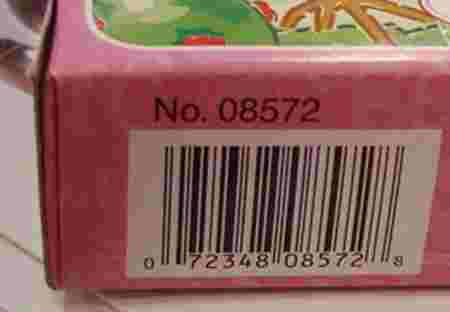
Most
retailers will accept item marking and labeling as provided by the manufacturer.
However some of the large retailers have developed specifications for
item labeling. In order to provide
some guidance we have selected a range of specifications to serve as a model.
If you have not applied GS1 barcodes to your items we suggest you use the
following models. If you have
applied GS1 labels to your products and they differ from this model we suggest
that you review your trading partner’s requirements.
All products sold in the supply chain are required to display
a GS1 bar code. The bar code on each item must meet GS1standards that ensure the
bar code can be scanned using optical scanning equipment. The GS1 must also
include the 12 or 13-digit series of numbers beneath the bars that presents the
encoded information in a human readable format. Vendors should validate that
every item shipped actually scans at the register in the retail store.
Non-compliance to GS1 bar code standards can result in your product being
removed from retail stores. It is recommended that all vendors install
scan-audit equipment to ensure that their bar codes on all items shipped scan
accurately. It is further recommended that verification equipment specifically
designed to analyze bar code quality be used. When this equipment is used bar
codes should rate a grade level "C" or better using ANSI standard method of quality
evaluation. Listed below are the minimum GS1 standards required.
Do…
-
Assign a
GTIN
number that is unique to each item
-
Assign
a separate GTIN number for each color, size and package
-
Print or
securely affix a GTIN-12, GTIN-13 or GTIN-8
-
Comply with
GS1 size requirements:
-
1.020” X
1.469”
-
Maximum
reduction factor – 80%
-
Maximum
expansion factor – 200%
-
Truncation
no less than ½” high
-
Allot
0.25” blank space on both sides of the symbol to prevent the optical scanners
from picking up stray markings
-
Print the
GS1 bar code in black ink on a white background
-
Never print
in red
-
Make sure
bar codes are printed clearly – no smudged or faded ink
-
Ensure easy
access to the bar code symbol by the optical scanner
-
Place the
bar code on the bottom, right-hand corner of the selling unit or packaging
-
Include
human-readable digits beneath the bar code symbol on all products
-
Verify that
the bar code scans properly prior to shipping.
-
Submit
notification of GTIN changes to customers at least 60 days in advance
-
Assign a new
GTIN bar code on new items or items that are changed significantly

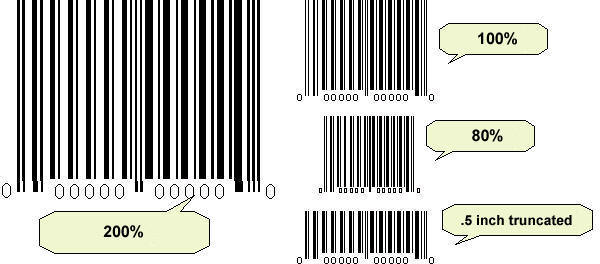
Don’t…
-
Use a new
GTIN when making price changes
-
Recycle a
GTIN that has been
used on a different current or discontinued item
-
Assign a unique
GTIN to
differentiate place of manufacture or a date code
For
more information, consult the rest of
the guidelines.
1.7.2 Blister Pack Merchandise
Labeling Requirements:
The retail price and SKU/Article number should appear on the
top-right corner on the front of the header card, unless otherwise
directed by your trading partner.
The retail price, if required should appear above the
SKU/Article number.
The GS1 number should appear on the back of the header card.

Packaging Requirements:
All blister pack products should be placed inside a standard
pack/carton for shipping (e.g. do not ship items “loose” or “as is”).
Pack only one SKU/Article per standard pack/carton (except
for agreed to and approved assortments).
1.7.3 Boxed Merchandise
Labeling Requirements:
The retail price and SKU/Article number should appear on the
top of the box, unless otherwise directed or agreed to with the customer.
The retail price should appear above the SKU/Article number.
The GS1 number should appear:
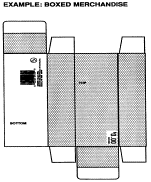
Packaging Requirements:
All boxed merchandise should be placed inside a standard
pack/carton for shipping (e.g. do not ship items “loose” or “as is”).
Pack only one SKU/Article per standard pack/carton (except
for customer approved assortments).
1.7.4 Floral Bushes, Picks and
Stems
Labeling
Requirements:
The retail price, SKU/Article number and GS1 bar code should
be placed on the silk floral bush stem using a butterfly sticker.
The butterfly sticker should be placed high on the product
between the branches to prevent the tag from tearing or falling off.
The tag should be a heavy, pliable gum label to withstand the
rigors of display and customer handling.
The retail price should appear above the SKU/Article number.
The plastic sleeve commonly placed over the silk floral bush
during shipping is thrown away prior to Store display. Therefore, do not sticker
the plastic sleeve on silk flowers.
Dried flowers, however, are displayed in the plastic sleeves.
In this case, the SKU/Article, GS1 and retail price stickers should be placed on
the plastic sleeve.
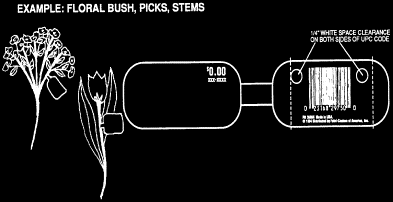
Packaging Requirements:
All floral merchandise should be placed inside a standard
pack/carton for shipping (e.g. do not ship items “loose” or “as is”).
Pack only one SKU/Article per standard pack/carton (except
for customer approved assortments).
1.7.5 Framing and Non-Boxed
Framed Art
Labeling Requirements:
The retail price, SKU/Article number and GS1 label showed be
placed on a sticker attached to the back of the merchandise, unless
otherwise directed by the customer.
The retail price should appear above the SKU/Article number.
Be sure the sticker is removable and does not damage the product.
Packaging Requirements:
All framing/framed art product should be placed inside a
standard pack/carton for shipping (e.g. do not ship items “loose” or “as
is”).
Pack only one SKU/Article per standard pack/carton (except
for customer approved assortments).
1.7.6 Furniture
Labeling Requirements:
The retail price, SKU/Article number and GS1 label should be
placed on a sticker attached to the back of the merchandise, unless
otherwise directed by the customer. If the merchandise will be damaged by a
sticker, a hangtag should be attached, providing the retail price, SKU/Article
number and GS1.
The retail price should appear above the SKU/Article number.
Be sure the sticker is removable and does not damage the product.
Packaging Requirements:
All furniture product should be placed inside a carton
for shipping (e.g. do not ship items “loose” or “as is”).
It may not always be practical to use cartons for some
oversized furniture products. For these items, special arrangements should be
made with the customer.
Pack only one SKU/Article per carton (except for customer
approved assortments).
1.7.7 By-The-Yard
(Reels/Spindles)
Labeling Requirements:
The SKU/Article number, vendor style number, GS1 and number
of yards should be labeled on each reel/spindle under any plastic wrap.
The retail price label should be included with the Packing
List to each Store.
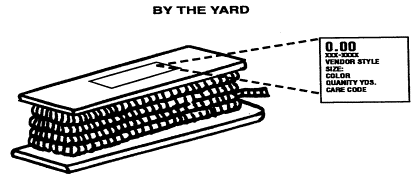
Packaging Requirements:
All by-the-yard product should be placed inside a carton
for shipping (e.g. do not ship items “loose” or “as is”).
Pack only one SKU/Article per carton (except for customer
approved assortments).
Product should be shipped according to the negotiated size.
Product shipped in a “sleeve” should be securely
sealed.
1.7.8 Other
Labeling Requirements:
For
all other hard items:
-
The
retail price, SKU/Article number and GS1 should be placed on a sticker
attached to the back of the merchandise. Be sure the sticker is removable
and does not damage the product.
-
The
retail price should appear above the SKU/Article number.
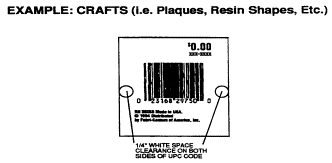
For merchandise sold in bags;
-
The
retail price, SKU/Article number and GS1 should be placed on a sticker
on the bag or pre-printed on the bag.
-
The
retail price should appear above the SKU/Article number.
-
The
SKU/Article number and the retail price should appear on the front
top-right corner of the merchandise bag.
-
The
GS1 should appear on the backside of the bag.
-
If the
merchandise cannot be seen because the sticker covers the merchandise, place
all labels on the backside of the merchandise.
-
Plastic bags less than .001 inches thick should contain the following
warning statement:
WARNING: KEEP THIS BAG AWAY FROM BABIES AND CHILDREN. DO NOT
USE IN CRIBS, BEDS, CARRIAGES AND PLAYPENS. THE THIN FILM MAY CLING TO NOSE AND
MOUTH AND PREVENT BREATHING.
For merchandise sold in
cylindrical containers (e.g. tins, paints, cans):
-
The
retail price and SKU/Article number should be placed on the front.
-
The
GS1 should be placed on the backside, bottom or top.
-
For
merchandise that is used by the consumer for decorating purposes (e.g.
decorative holiday tins), the markings should be on the bottom.
-
The
retail price should appear above the SKU/Article number.
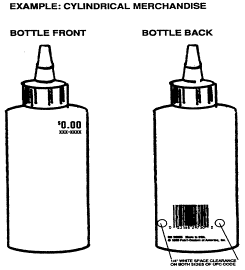
For ready-to-wear merchandise (e.g., sweatshirts,
costumes):
-
The
retail price, SKU/Article number and GS1 should be on the same hangtag that
contains the product information such as size, color, style and vendor.
-
The
retail price should appear above the SKU/Article number.
-
Finished Garments/Ready-to-Wear merchandise should be shipped in a clear
plastic bag. Plastic bags less than .001 inches thick should contain the
warning statement listed in the labeling instructions above.

Packaging Requirements:
-
All product should be
placed inside a standard pack/carton for shipping (e.g. do not ship
items “loose” or “as is”).
-
Pack only one SKU/Article
per carton (except for customer approved assortments).
-
Product should be packed
appropriately as to ensure saleable merchandise at the Store.
1.8 Material Safety Data Sheets (MSDS)
1.8.1
General
The
Occupational Safety and Health Administration (OSHA) has developed a basic
Material Safety Data Sheet (MSDS) form in an attempt to establish a common
database for each hazardous chemical used in the United States. While companies
are not required to use the OSHA form, they are required to maintain the same
information contained on those forms for any hazardous substances that they
produce. OSHA defines a hazardous
material as any substance that has a physical or health hazard, considering
available scientific evidence. It is the responsibility of the manufacturer or
vendor to perform a hazard determination or assure that an appropriate hazard
determination is conducted on your product to determine if the product requires
an MSDS.
1.8.2
Requirements
An
MSDS should be provided for each hazardous material or for each good containing
any hazardous material supplied to a customer. Each MSDS describes:
-
Description of the chemical
-
Name and location of manufacturer
or distributor
-
Why the chemical is hazardous
-
Risks and conditions if exposed
to the substance(s)
-
Safe-handling procedures
-
Protection guidelines for working
with the substance(s)
-
What to do if you are exposed
-
How to handle a spill or
emergency
The MSDS
should be provided to the customer prior to the time of first shipment, at any
time information changes on the MSDS, or any time that customer requests an MSDS.
You should also provide an MSDS for any sample product that presents or contains
a physical or health hazard prior to the time that the sample product is shipped
to the customer.
It
is also the responsibility of the manufacturer or vendor to ensure that any
product shipped to the customer bears an appropriate label in accordance with
OSHA’s hazard communication standard. OSHA requires the manufacturer, importer
or distributor to ensure that each hazardous substance is labeled, tagged or
marked with its identity, appropriate hazard warnings and the name and address
of the manufacturer, importer, or other responsible party. Upon request, the
customer should be provided with an appropriate label.
1.9
Product Safety and Product Safety Labeling
1.10
Shipment Packaging and Pallets
1.
Carton Packaging
-
Use
a carton of at least 175 pound test strength
-
Use
adequate cushioning material
-
Secure
with polypropylene film tape designed for shipping
-
Be
sure to discuss the use of metal or plastic banding to secure master cartons,
inner pack boxes, or pallets with your trading partners if you intend to use
them
-
Product
with sharp edges should be wrapped with bubble wrap before placing in container
-
Do
not use peanuts or paper fillers unless approved by retailer
-
Weight
over 40lbs – Label for two-person lift required. (Graphic may be requested)
2.
Pallet Requirements & Stacking Guidelines
-
Palletize > 300lbs if not going
directly to store.
-
Pallets less than 50” double
stack.
-
Pallets less than 34” will triple
stack.
-
Pallet should not exceed 84” in
height including pallet.
-
Product should not hang over pallet
-
Pallet Types – Grade A-B grocery
manufacturers approved 48”x40# standard four way pallet.
-
Grade A – New pallet free of
defects
-
Grade B – Used with minimum
amount of reinforced or corrected spots
-
Secured by placing shrink-wrap
around pallet
-
Minimal
cardboard or banding may also be used to secure shipment.
-
Consolidation of one or more SKU
same order allowed on pallet keeping SKU’s packed together on same pallet.
BACK TO TOP
NEXT >>
|
